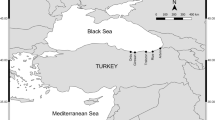Synopsis
Food consumption by the holocephalanCallorhynchus callorhynchus, the ‘cock fish’, was studied in the northern San Matías Gulf, Argentine Patagonia. Relative gut fullness was assessed objectively with reference to estimated maximum fullness. Analysis of stomach contents of samples from the commercial catch shows maximum gut fullness during the spring. No diel cycle in gut fullness could be detected in the course of an experimental survey. Rate of gastroenteric emptying was estimated on board a research vessel by sacrificing at varying time periods fish kept in circulating sea water. Daily consumption rate by an adult fish of average size was estimated to be 1.4% of its body weight, very close to figures estimated for elasmobranchs from cold temperate waters; this is the first estimation of consumption rate by a holocephalan. Approximately half of the cock fish diet is composed of scallops, including the commercially importantAequipecten tehuelchus. It was calculated that consumption of this species in the study area reaches 81 metric tons per month, which corresponds to 5–7% of its estimated natural mortality.
Similar content being viewed by others
References cited
Bahamonde, N. 1950. Alimentación del peje gallo (Callorhynchus callorhynchus). Investigaciones Zoológicas Chilenas 1: 4–6.
Clark, E. 1963. The maintenance of sharks in captivity with a report on their instrumental conditioning: pp. 115–149.In: P.W. Gilbert (ed.) Sharks and Survival, Health & Co., Washington,D.C.
Cortés, E. & H. Gruber. 1990. Diet, feeding habits, and daily ration of young lemon sharks, Negaprion brevirostris, and the effect of ration size on their growth and conversion efficiency. Copeia 1990: 204–218.
Cortés, E. & H. Gruber. 1992. Gastric evacuation in the young lemon shark, Negaprion brevirostris, under field conditions. Env. Biol. Fish. 35: 205–212.
Dell, R.K., 1964. Antarctic and subantarctic Mollusca: Amphineura, Scaphopoda and Bivalvia. Discovery Reports 33: 93–250.
Di Giácomo, E.E. & M.R. Perier. 1991. Evaluación de la biomasa y explotación comercial del pez gallo (Callorhynchus callorhynchus) en el Golfo San Matías, Argentina. Frente Marítimo 9: 7–13.
Elliot, J.M. & L. Persson. 1978. The estimation of daily rates of food consumption for fish. J. Animal Ecol. 47: 977–991.
Glorioso, P. 1987. Temperature distribution related to shelf-area fronts on the Patagonian Shelf. Cont. Shelf Res. 7: 27–34.
Iribarne, O.O., M.L. Lasta, H.C. Vacas, A.M. Parma & M.S. Pascual. 1990. Assessment of abundance, gear efficiency and disturbance in a scallop dredge fishery: results of a depletion experiment. pp. 242–248. In: S. Shumway (ed.) An International Compendium of Scallop Biology and Culture, World Aquaculture Workshops 1.
Jobling, M. 1986. Mythical models of gastric emptying and implications for food consumption studies. Env. Biol. Fish. 16: 35–50.
Jones, B.C. & G.H. Geen. 1977. Food and feeding of spiny dogfish (Squalus acanthias) in British Columbia waters. J. Fish. Res. Board Can. 34: 2067–2078.
Longval, M., R.M. Warner & S.H. Gruber. 1982. Cyclical patterns of food intake in the lemon shark, Negaprion brevirostris, under controlled conditions. Florida Scientist 45: 25–33.
Macpherson, E., J. Lleonart & P. Sanchez. 1989. Gastric emptying in Scyliorhinus canicula (L.): a comparison of surface-dependent and non-surface dependent models. J. Fish Biol. 35: 37–48.
Maller, R.A., E.S. Boer, L.M. Joll, D.A. Anderson & J.P. Hinde. 1983. Determination of the maximum foregut volume of western rock lobsters (Panulirus cygnus) from field data. Biometrics 39: 543–551.
Medved, R.J. 1985. Gastric evacuation in the sandbar shark (Carcharhinus plumbeus). J. Fish Biol. 26: 239–253.
Molina, D., H.C. Elgueta & H. Osorio. 1980. Contenido gástrico de Callorhynchus callorhynchus (Linnaeus, 1758) capturado entre Algarrobo y Pupuya (Chile) (Holocephali, Callorhynchidae). Noticiario Mensual del Museo Nacional de Historia Natural de Chile 279–280: 4–10.
Molina, J.I. 1808. The geographical, natural and civil history of Chile. Middletown. 271 pp. (translation of the original Italian edition of 1787).
Mullen, A.J. 1986. The effect of the choice of evacuation model on the estimation of feeding rate. Env. Biol. Fish. 16: 213–217.
Orensanz, J.M., A.M. Parma & O.O. Iribarne. 1991. Population dynamics and management of natural stocks. pp. 625–713.In: S.E. Shumway (ed.) Scallops: Biology, Ecology and Aquaculture,Elsevier Publishers, London.
Orensanz, J.M., M.S. Pascual & M.E. Fernández. 1991. Fisheries and aquaculture of scallop species from Argentina. pp. 981–996.In: S.E. Shumway (ed.) Scallops: Biology, Ecology and Aquaculture, Elsevier Publishers, London.
Pandian, T.J. & E. Vivekanandan. 1985. Energetics of feeding and digestion. pp. 99–124. In: P. Tytler & P. Calow (ed.) FishEnergetics: New Perspectives, Croom Helm Publishers, London.
Patterson C. 1992 Interpretation of the toothplates of chimaeroid fishes. Zool. J. Linn. Soc. 106: 33–61.
Persson, L. 1986. Patterns of food evacuation in fishes: a critical review. Env. Biol. Fish. 16: 51–58.
Ribbink, A.J. 1971. The jaw mechanism and feeding of the holocephalan, Callorhynchus capensis Dumerill. Zoologia Africana 6: 45–69.
Ríos, E.C. & J. Pereira. 1986. ‘Pez elefante’, un pez malacófago. Comunicaciones de la Sociedad Malacológica del Uruguay 51: 427–428.
Schurdak, M.E. & S.H. Gruber. 1989. Gastric evacuation of the lemon shark Negaprion brevirostris (Poey) under controlled conditions. Exp. Biol. 48: 77–82.
Stillwell, C.E. & N.E. Kohler. 1982. Food, feeding habits, and estimates of daily ration of the shortfin mako (Isurus oxyrinchus) in the Northwest Atlantic. Can. J. Fish. Aquat. Sci. 39: 407–414.
Vermeij, G.J. 1987. Evolution and escalation. An ecological history of life. Princeton University Press. New Haven. 527 pp.
Author information
Authors and Affiliations
Rights and permissions
About this article
Cite this article
Di Giácomo, E., Parma, A.M. & Orensanz, J.M. Food consumption by the cock fish,Callorhynchus callorhynchus (Holocephali: Callorhynchidae), from Patagonia (Argentina). Environ Biol Fish 40, 199–211 (1994). https://doi.org/10.1007/BF00002546
Received:
Accepted:
Issue Date:
DOI: https://doi.org/10.1007/BF00002546




